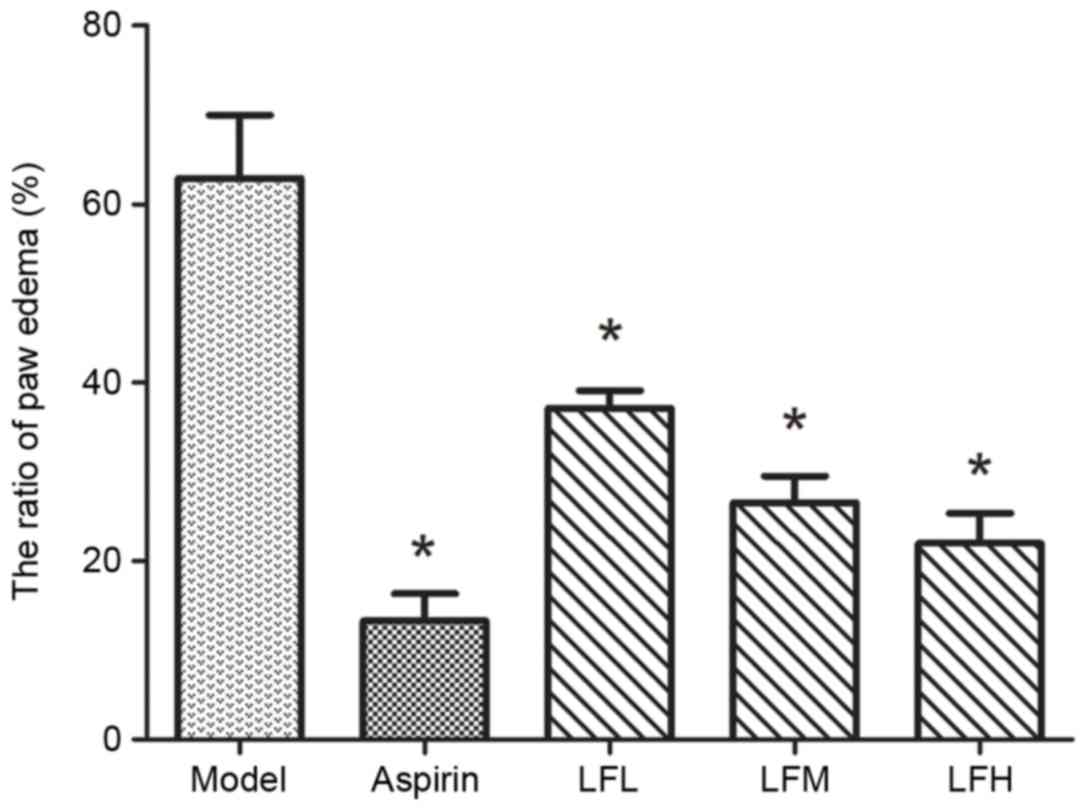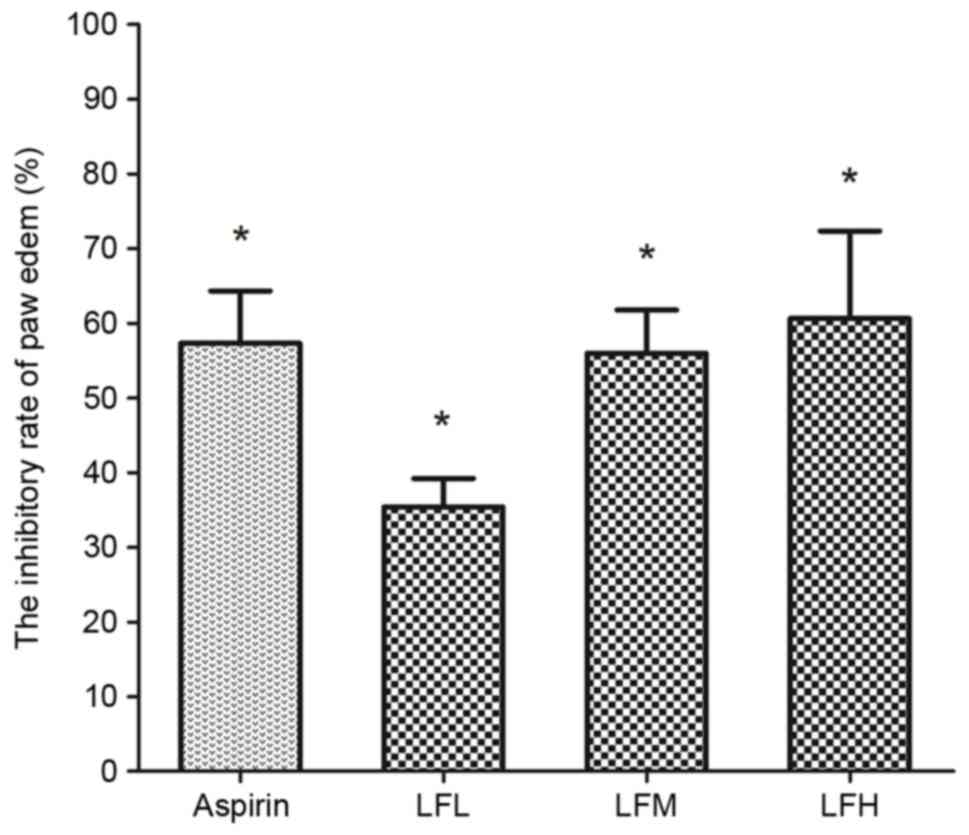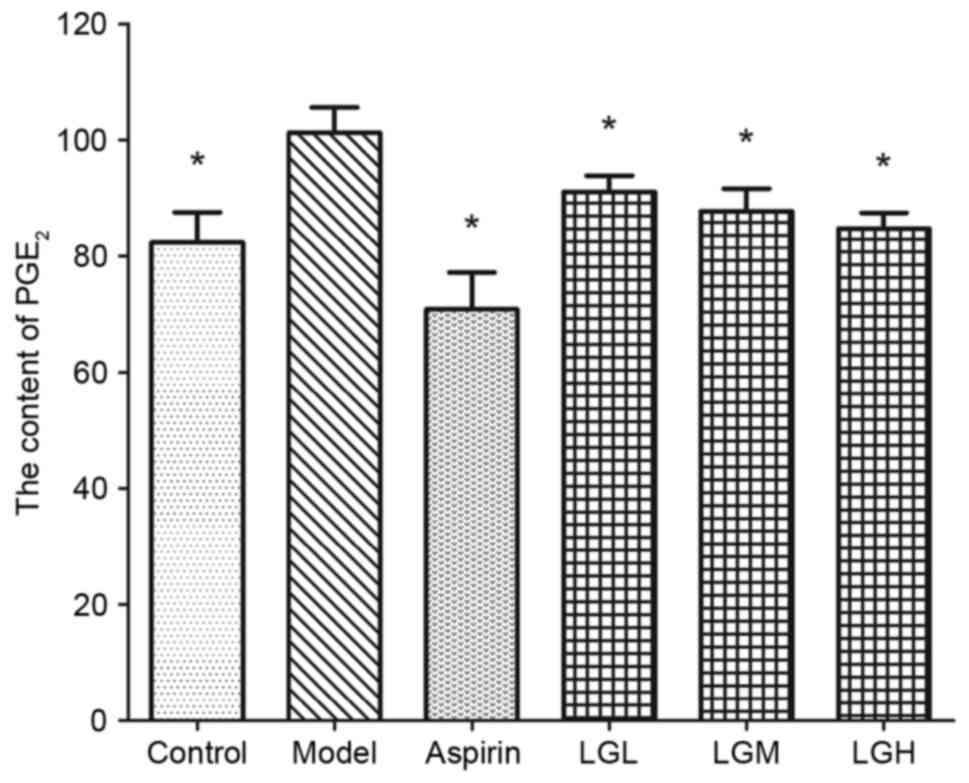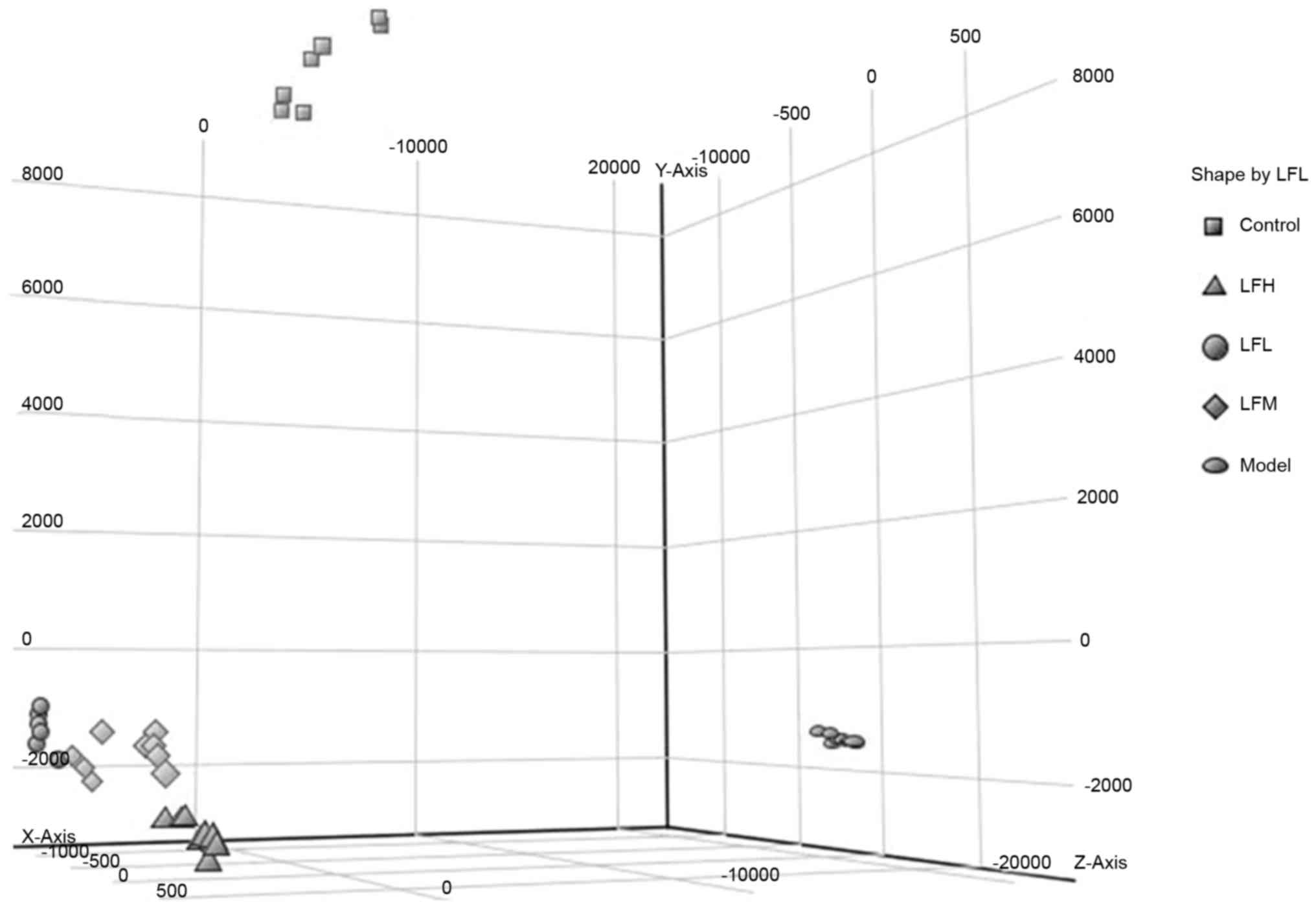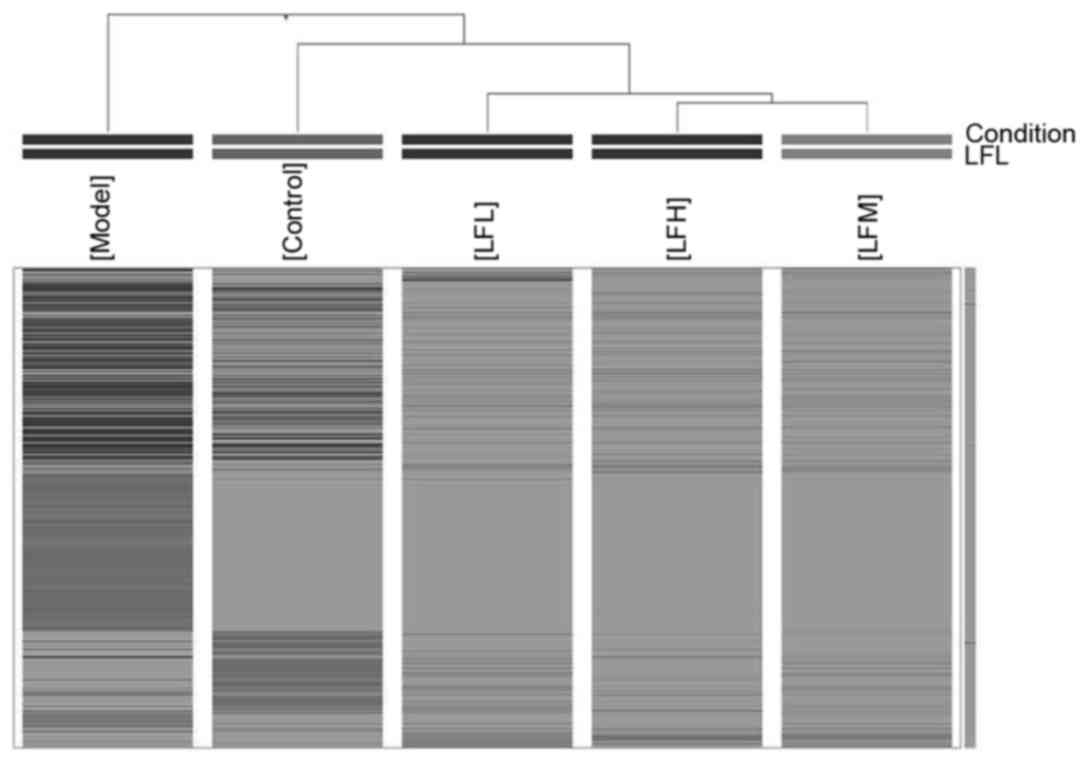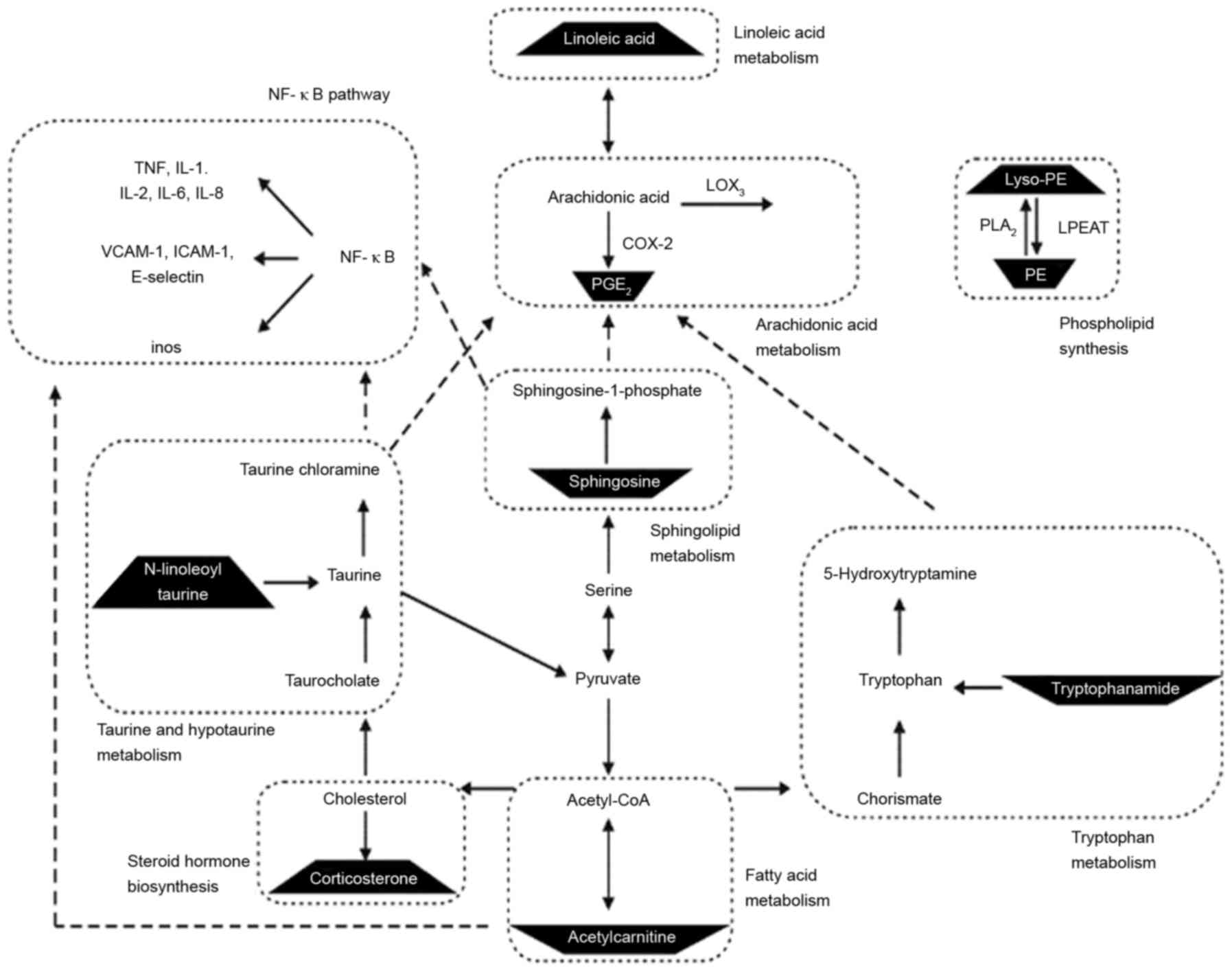Introduction
Inflammation is considered to be a primary
physiological defense mechanism and is associated with the
protection of the body against burns, infections, toxic chemicals,
allergens and other harmful stimuli. These stimuli may induce local
and systemic effects, signs of which may include pain, redness,
swelling, heat, and loss of function in the affected area (1,2). The
mechanisms and mediators that contribute to the induction and
exacerbation of inflammation are complex, and may involve enzyme
activation, mediator release, extravasation of fluid, cell
migration, tissue breakdown and tissue repair (3). Inflammation may become a causative
factor for other chronic diseases, including rheumatoid arthritis
(4,5)
and atherosclerosis (6,7), if not controlled. Current treatments
for inflammation include non-steroidal anti-inflammatory drugs and
steroids; although these treatments have merits, potential risks
and side effects (particularly to the gastrointestinal tract) are
widely reported, and restrict clinical application (8,9).
Numerous traditional Chinese medicines (TCMs) have been widely used
as preventive or therapeutic strategies in modern medicine. TCMs
boast antioxidant, anti-inflammatory, anti-apoptotic and autophagic
regulatory functions, of which the anti-inflammatory activities
have been extensively reported (10–12).
Glycyrrhiza comes from the roots and rhizomes
of Glycyrrhiza uralensis Fisch., Glycyrrhiza inflata
Bat. or Glycyrrhiza glabra L. (13). Use of Glycyrrhiza was first
reported in ‘Shen Nong's Herbal Classic’ in around 2100 BC and
recorded in each version of ‘Chinese Pharmacopoeia’.
Glycyrrhiza is a widely used herbal medicine native to
southern Europe and regions of Asia. In China it is widespread in
Inner Mongolia, Gansu, Heilongjiang, Ningxia, Qinghai and a number
of other provinces (14). Owing to
Glycyrrhiza's diverse chemical composition and its wide
range of pharmacological effects, it has been documented as having
various therapeutic applications (15). The main components of licorice are
triterpenoids and flavonoids (16,17).
Licorice flavonoids contain licochalcone A, liquiritigenin,
glabridin, glycyrol and numerous other monomer components that are
known to have biological activities, which include
anti-inflammatory, antidepressant, and antitumor effects (18–21).
In the present study, a metabolomic approach was
applied to investigate the anti-inflammatory effect of licorice
flavonoids in formaldehyde-injected mice, and to identify the
metabolic pathways and potential biomarkers associated with
inflammation. The present study may aid the understanding of the
underlying mechanisms of action of licorice flavonoids in the
suppression of inflammation, providing a theoretical foundation for
the development of licorice flavonoids to be applied
clinically.
Materials and methods
Reagents and materials
Aspirin enteric-coated tablets were purchased from
Bayer (Shanghai, China). Formaldehyde was purchased from Longhai
Dandong Reagent Factory (Dandong, China). Potassium hydroxide was
purchased from Tianjin Kaixin Chemical Industry Co., Ltd. (Tianjin,
China). High-performance liquid chromatography (HPLC)-grade
acetonitrile was purchased from J. T. Baker (Thermo Fisher
Scientific, Inc., Waltham, MA, USA). HPLC-grade formic acid was
purchased from Fluka (Merck & Co., Inc., Whitehouse Station,
NJ, USA). Ultrapure water (18.2 MSZ) was prepared with a Milli-Q
water purification system (Merck KGaA, Darmstadt, Germany).
Licorice was collected in Tongliao, the Inner
Mongolia Autonomous Region in China at locations between
42°15′N-45°41′N and 119°15′E-123°43′E. In the Chinese Pharmacopoeia
(2015 edition) the liquiritigenin and glycyrrhizic acid content is
required to be >0.50 and >2.0%, respectively (22). The licorice used in this experiment
contained 1.84 and 2.57% of liquiritigenin and glycyrrhizic acid,
respectively, in accordance with the relevant provision of Chinese
Pharmacopoeia. Licorice flavonoids were prepared as previously
described (23). The average paste
rate was 5.40%; the purity of total flavonoids reached up to 90%,
as detected by HPLC method (24),
primarily contained 1.1695% liquiritin apioside, 1.8402%
liquiritin, 0.2087% isoliquiritin apioside, 0.2042% ononin, 0.4023%
isoliquiritin, 0.6443% liquiritigenin, 0.1548% calycosin and
0.0726% isoliquiritigenin.
Animals
A total of 54 male Kunming mice weighing 18–22 g
were provided by Liaoning Biological Technology Co., Ltd.
(Liaoning, China). The mice were bred in a specific pathogen-free
environment and had free access to a standard diet and tap water.
The animals were housed in stainless steel metabolic cages under
standard humidity (50±10%), temperature (25±2°C) and light (12/12 h
light/dark cycle). All animal treatments were conducted in strict
accordance with the National Institutes of Health Guide to the Care
and Use of Liaoning University of Traditional Chinese Medicine, and
the present study was approved by Attitude of the Animal Core and
Welfare Committee of Liaoning University of Traditional Chinese
Medicine.
Animal handling
Mice were divided randomly into 6 groups (n=9).
These groups were: The control group (mice injected with 0.05 ml
saline into the sub-plantar region of the right hind paw), the
model group (mice injected with 0.05 ml 2.5% formaldehyde solution
into the sub-plantar region of the right hind paw), the licorice
flavonoid high-dose group (treated with 0.65 g/kg of licorice
flavonoids), the middle-dose group (0.21 g/kg of licorice
flavonoids), the low-dose group (0.07 g/kg of licorice flavonoids)
and the aspirin group (0.04 g/kg of aspirin). All mice were orally
administered the active group solution twice daily (control and
model groups were administered saline) for 3 days. The mice were
prohibited any food for 24 h before the final day of the
experiment, but were allowed ad libitum access to water. At
1 h after the last administration, the paw volume of mice in each
group prior to inducing inflammation was measured with a self-made
foot volume-measuring device. Subsequently, mice were injected with
0.05 ml of 2.5% formaldehyde solution into the sub-plantar region
of the right hind paw except control group (25). Following inducing inflammation 24 h,
the paw volume was measured with a self-made foot volume-measuring
device again; the ratio of paw edema (%) and the inhibitory rate of
paw edema (%) were taken as indexes of detection. Mice were then
anesthetized and sacrificed, blood was collected into Na-heparin
tubes and plasma was obtained following centrifugation (1,006.2 ×
g, 4°C for 15 min), and stored at −80°C until metabolomics analysis
were performed. The inflammatory paws of the mice from their right
ankle were removed, weighed, and soaked for 1 h with 3 ml normal
saline (precooled to <4°C). Following centrifugation (1,006.2 ×
g, 4°C for 15 min) of the solution, 2 ml supernatant was absorbed
and mixed with 2 ml of 0.15 mol l−1 KOH-CH4O
solution, samples were incubated in water bath for 20 min at 50°C,
then the content of prostaglandin E2 (PGE2) was detected with a UV
spectrophotometer at a wavelength of 278 nm once the liquid had
cooled.
Sample preparation
The blood samples were thawed prior to analysis and
100-µl aliquots of bloods were added to 400 µl methanol. The
mixture was vortexed for 3 min and centrifuged at 1,006.2 × g for
15 min at 4°C. The supernatant was then transferred to auto-sampler
vials. A pooled quality control (QC) sample was made by mixing
20-µl aliquots of each sample, using the same method as that used
for each of the other samples. The pooled QC sample was analyzed
randomly through the analytical run to monitor instrument
stability. In addition, a random sample was divided into 6 and was
treated in the same way. These 6 samples were continuously analyzed
to validate the repeatability of the sample preparation method.
HPLC-quadrupole-time of flight
(Q-TOF)-mass spectrometry (MS) conditions
Metabolic profiling of the blood serum was conducted
using an Agilent-1260 LC system coupled with an Agilent-6530 Q-TOF
mass spectrometer (Agilent Technologies, Inc., Santa Clara, CA,
USA). Plasma chromatographic separation was performed on an Agilent
Poroshell 120 SB-C18 column (2.7 µm, 4.6×100 mm; Agilent
Technologies, Inc.) with the temperature of the column set at 45°C.
The flow rate was 1.0 ml/min and the mobile phase was ultrapure
water with 1‰ formic acid and 1‰ acetonitrile The gradient elution
of acetonitrile was performed as follows: 5–30% acetonitrile at 0–4
min; 30–67% acetonitrile at 4–6 min; 67–98% acetonitrile at 6–11
min; 98–100% acetonitrile at 11–17 min; followed by a 7-min
re-equilibration step. The volume of sample injected was 1 µl. The
parameters of mass detection were set as followed: In positive
mode, the flow rate of the dry gas of MS mode was 9 l/min, Vcap
4000 V; the nebulizer pressure was 45 psig; the fragmentation
voltage was 175 V; the Sheath Gas Temp was 350°C; the Sheath gas
velocity was 12 l/min; the acquisition rate was 25 Spectra/sec; MS
data were acquired in full-scan mode from m/z 50 to 1,050 amu; and
the collision energy of MS/MS date acquisition was set at 20 eV.
The corrected mixed solution (Agilent Technologies, Inc.;
m/z=121.050873, 149.02332, 922.009798) was used as the lock
mass.
Data processing
The raw MS data were exported by Agilent Mass Hunter
Qualitative Analysis software (vB.04.00; Agilent Technologies,
Inc.) for peak detection, alignment and filtering (Agilent
Technologies, Inc.). Integrated information of the retention time
and molecular mass were then outputted from the Agilent Mass
Profiler software (vB.02.00; Agilent Technologies, Inc.). Finally,
principal components analysis (PCA), the cluster analysis used for
multivariate analysis and one-way analysis of variance (ANOVA) used
for expressing the significance of data were performed with Mass
Profiler Professional (MPP) 12.6 software (Agilent Technologies,
Inc.), as described previously (26). The metabolites were preliminarily
identified in METLIN (https://metlin.scripps.edu/landing_page.php?pgcontent=mainPage)
and PUBCHEM (https://www.ncbi.nlm.nih.gov/pccompound/) databases,
and biochemical reactions involving the identified metabolites were
obtained through KEGG (http://www.kegg.jp/), HMDB (http://www.hmdb.ca/) and LIPID MAPS (http://www.lipidmaps.org/) databases.
Statistical analysis
SPSS 19.0 statistical software (IBM SPSS, Armonk,
NY, USA) was used for statistical analysis, and one-way ANOVA was
used to design the group data followed by Student-Newman-Keuls
test. Student's t-test was used to analyze the different
metabolites between the groups with MPP software. All quantitative
data are expressed as the mean ± standard deviation, as indicated.
P<0.01 was considered to indicate a statistically
significant difference.
Results
Effects of licorice flavonoids on
formalin-induced inflammation in mice
The inhibitory effects of different doses of groups
on formalin-induced paw edema in mice are shown in Figs. 1 and 2. The degree of paw edema in the model
group was substantially higher compared with that in control group
(no inflammation), indicating that the acute inflammation model was
successfully established (data not shown). Compared with the model
group, the ratio of paw edema [(the volume of paw after
inflammation-the volume of paw before inflammation)/the volume of
paw after inflammation)] in each administered group was
significantly lower (P<0.01), among which aspirin group, the
inhibition rate of the high- and middle-dose licorice flavonoid
groups reached >50% (Fig. 2),
indicating that licorice flavonoids inhibited the increase of
inflammatory mediators caused by formalin stimuli. In addition, the
content of PGE2 in the model group significantly increased when
compared with the control group (Fig.
3), which indicated that the inflammation in the paws of the
mice caused by formalin is able to raise the PGE2 level in
vivo. The content of PGE2 in the licorice flavonoid dose groups
was significantly decreased compare to that of model group
(P<0.01), suggesting that licorice flavonoid can inhibit
inflammation though regulating the level of PGE2.
PCA and cluster analysis of
metabolites
PCA and hierarchical clustering analysis were used
to classify the metabolic phenotypes and identify the different
metabolites. On the observation of 3-dimensional plots, samples in
the same group were evidently clustered and the model group
differed significantly from others (Fig.
4), indicating that the endogenous metabolites in the
formalin-induced paw edema in the model group differed
significantly from the drug-treated groups. The spatial position of
the licorice flavonoid groups was close to that of the control
group, demonstrating that the plasma metabolite composition of
inflammation mice has a tendency to return to normal following
treatment. Clustering analysis of metabolomics data also revealed
distinct segregation between the control, model and licorice
flavonoid dose groups (Fig. 5).
Identification of endogenous
metabolites with differing levels
Small molecule metabolites whose levels appeared to
differ significantly (P<0.05) between licorice flavonoids, model
and control groups were analyzed using MPP software. According to
the MS/MS fragments of differing endogenous metabolites, compared
with METLIN, PUBCHEM and other associated databases, 9 metabolites
associated with inflammation were preliminary identified (Table I).
 | Table I.Identified endogenous metabolites
with difference and metabolic pathway between groups. |
Table I.
Identified endogenous metabolites
with difference and metabolic pathway between groups.
| Identity | RT, min | Molecular mass,
Da | Fragment ions | Molecular
formula | Regulation (vs.
model group) | Metabolic
pathway |
|---|
|
Tryptophanamide | 1.44 | 203.1059 | 187, 159 |
C11H13N3O | Down | Tryptophan
metabolism |
|
Acetylcarnitine | 1.70 | 203.1172 | 85, 60 |
C9H17NO4 | Down | Fatty acid
metabolism |
| Linoleic acid | 6.17 | 280.2406 | 69, 83, 97 |
C18H32O2 | Up | Linoleic acid
metabolism |
| PE [19:0/22:6 (4Z,
7Z, 10Z, 13Z, 16Z, 19Z)] | 6.88 | 805.5621 | 184 |
C46H80NO8P | Down | Phospholipid
synthesis |
| N-linoleoyl
taurine | 7.29 | 387.2443 | 117, 207, 149 |
C20H37NO4S | Up | Taurine and
hypotaurine metabolism |
| LysoPE [0:0/20:3
(8Z, 11Z, 14Z] | 7.68 | 525.2855 | 89, 184, 327,
526 |
C27H44NO7P | Up | Phospholipid
synthesis |
| Leukotriene B4 | 8.06 | 336.4656 | 189, 119, 105 |
C20H32O4 | Down | AA metabolism |
| Corticosterone | 10.22 | 346.2152 | 347, 97, 109 |
C21H30O4 | Up | Steroid hormone
biosynthesis |
| Sphingosine | 13.92 | 299.2824 | 282, 252 |
C18H37NO2 | Down | Sphingolipid
metabolism |
Pathway analysis
The pathways associated with endogenous metabolites
and anti-inflammatory effects of licorice flavonoids are listed in
Table I and Fig. 6. These metabolites were identified to
be involved in pathways, including in arachidonic acid (AA)
metabolism, tryptophan metabolism, sphingolipid metabolism,
according to HMDB, KEGG, LIPID MAPS and other backend knowledge
databases.
Discussion
AA is a polyunsaturated fatty acid that is present
in mammalian systems. Cyclooxygenase (COX) and lipoxygenase (LOX)
pathways are the two major enzymatic pathways involved in AA
metabolism, and are associated with inflammation (27). In the present study, licorice
flavonoids regulated a variety of endogenous metabolites associated
with AA metabolism to mediate its anti-inflammatory effect. In
metabolic networks, lipid metabolism and inflammation are
associated (28,29) and there is a mutual transformation
association between linoleic acid and AA (30): As the level of AA decreases, linoleic
acid levels increase. The results of the present study indicated
that the content of linoleic acid in the plasma of the mice
administered licorice flavonoids was higher compared with that in
the model group, which may influence the AA metabolism level and
alleviate inflammation (Table I;
Fig. 6). In a process catalyzed by
sphingosine kinases 1 and 2, sphingosine-1-phosphate (S1P) is
formed by the phosphorylation of sphingosine (31), and is recognized as an important
intracellular and extracellular messenger, participating in
inflammatory signaling pathways (32–34).
Nuclear factor-κ-light-chain-enhancer of activated B cells (NF-κB)
are reported be responsible for the transcriptional activation of a
number of inflammatory mediators (35–37),
which regulate the expression of a variety of different genes and
enzymes, including prostaglandin-endoperoxide synthase 2 (COX-2),
interleukin (IL)-1, IL-6, IL-8, chemokines, and tumor necrosis
factor (TNF) (38–40). Following the oral administration of
licorice flavonoids, the content of sphingosine decreased in the
serum of mice, then downregulated S1P, which transcriptionally
regulates the transient expression of COX-2 and PGE2 (41,42),
from AA metabolism and NF-κB metabolism pathway to reduce the
production of inflammatory factors.
The monoamine 5-hydroxytryptophan (5-HT, also known
as serotonin), serves an important role in evaluating the
inflammatory condition of the body (43). When cells are stimulated by
environment triggers, 5-HT is released from cell particles into the
bloodstream, resulting in an increase in vascular permeability,
which leads to inflammation. Tryptophanamide is a substrate of
tryptophan aminopeptidase and is converted to L-tryptophan by
enzymatic hydrolysis. In the presence of tryptophan hydroxylase,
L-tryptophan generates 5-HT (44).
In the present study, licorice flavonoids also downregulated the
content of tryptophanamide, resulting in a decrease in the content
of 5-HT and thus the indirect downregulation of PGE2 (45). The lower concentration of PGE2 in the
inflamed mouse tissues verified the accuracy of the results.
Additionally, the level of an important inflammatory mediator,
leukotriene B4, in the mice administered licorice
flavonoids was decreased, which demonstrated its anti-inflammatory
action from the LOXs pathway.
Taurine has been associated with potent
anti-inflammatory effects in a variety of models of systemic
inflammation (46). In the body,
taurine is chlorinated to form taurine chloramine, which inhibits
the generation of macrophage inflammatory mediators, including NO,
TNF, and PGE2 (47). The present
study demonstrated that licorice flavonoids upregulate the level of
N-linoleoyl taurine, a derivative of taurine, which may serve an
indirect anti-inflammatory role (Table
I; Fig. 6).
Corticosterone is the metabolite of cortisol, which
is a corticosteroid hormone produced by the adrenal cortex. The
anti-inflammatory effects of corticosterone have been reported
previously (48,49). In the present study, the content of
corticosterone in the mice administered with licorice flavonoids
was higher compared with that in the model group, indicating that
flavonoids may alleviate inflammation through the steroid hormone
biosynthesis pathway.
L-acetylcarnitine is an acetic acid ester of
carnitine that facilitates the movement of acetyl-coenzyme A into
the matrices of the mammalian mitochondria during the oxidation of
fatty acids. It promotes the production of pro-inflammatory
cytokines, including TNF, IL-6 and IL-1β (50). In the serum of licorice flavonoids
groups, the level of L-acetylcarnitine was decreased, indicating
that flavonoids may influence fatty acid metabolism to serve
anti-inflammatory roles.
Phospholipids are components of cell membranes;
their metabolites participate in phospholipid maintenance of normal
physiological function. Abnormalities in phospholipid metabolism
may promote systemic inflammation (51). Lysophosphatidylethanolamine (LysoPE)
and phosphatidylethanolamines (PE) are important phospholipid
synthetic pathway intermediates; licorice flavonoids may influence
the phospholipid synthetic pathway to alleviate inflammation.
Licorice flavonoids possess the same mechanism of
regulating AA metabolism and the NF-κB metabolism pathway to
relieve inflammation as aspirin. Additionally, they may also
influence phospholipid synthesis and steroid hormone biosynthesis
to promote anti-inflammatory effects, revealing a multiple pathway
regulation function of licorices flavonoids (52,53).
In the present study, on the basis of prominent
anti-inflammatory effect, the mechanism of action of licorice
flavonoids was assessed via metabolomic analysis, using
HPLC-Q-TOF/MS. The results of pharmacodynamics analysis
demonstrated that licorice flavonoids inhibited
formaldehyde-induced mice paw edema and relieved inflammation,
presenting a remarkable dose-effect association. Furthermore, it
has been speculated that licorice flavonoids is able to regulate
the levels of endogenous metabolites in mice, including linoleic
acid, sphingosine, tryptophanamide, N-linoleoyl taurine,
corticosterone, L-acetylcarnitine, leukotriene B4,
PE[19:0/22:6(4Z,7Z,10Z,13Z,16Z,19Z)] and
LysoPE[0:0/20:3(8Z,11Z,14Z)], involving the metabolism of AAs,
sphingolipid, tryptophans, fatty acids, taurine, hypotaurine and
linoleic acid, and the synthesis of phospholipids and steroid
hormones. Understanding of the multi-pathway integrated adjustment
mechanism of licorice flavonoids may aid in the reduction of side
effects along with their anti-inflammatory functions, and provides
a foundation for identifying and developing novel, high-potential
natural drugs with fewer side effects for clinical use.
Acknowledgements
The authors wish to thank Dr Nannan Li, Mr Hechen
Wang, Mrs Lulu Tian and Mrs Yanan Zhang (Liaoning University of
Traditional Chinese Medicine, Dalian, China) from our research team
for their work on the present study.
Funding
The present study was supported by grants from the
National Natural Science Foundation of China (grant no. 81241111),
the Project of Institutions to Support Higher Learning Talents in
Liaoning Province (grant no. LR2013044) and Eleventh Five-Year
Plan, Significant New Medicines Creation, Science and Technology
Major Special Project (grant no. 2010ZX09401-304-201).
Availability of data and materials
The datasets used and/or analyzed during the current
study are available from the corresponding author on reasonable
request.
Authors' contributions
XY, XM and GY conceived and designed the
experiments. XY, XC, WX and YB performed the experiments. TL, SW
and TB analyzed the data. XY wrote the paper.
Ethics approval and consent to
participate
Ethics approval was granted by the Attitude of the
Animal Core and Welfare Committee of Liaoning University of
Traditional Chinese Medicine (reference no. 20150702).
Patient consent for publication
Not applicable.
Competing interests
The authors confirm that no conflicts of interest
exist.
References
|
1
|
Kumar V, Abbas AK and Fausto N: Robbins
and Cotran Pathologic Basis of Disease7th. Elsevier Saunders;
Philadelphia: 2004
|
|
2
|
Henson PM and Murphey RC: Mediators of the
Inflammatory Process (Handbook Of Inflammation)Elsevier; Amsterdam:
1989
|
|
3
|
Vane JR and Botting RM: New insights into
the mode of action of anti-inflammatory drugs. Inflamm Res.
44:1–10. 1995. View Article : Google Scholar : PubMed/NCBI
|
|
4
|
Lane MA, Mcdonald JR, Zeringue AL, Caplan
L, Curtis JR, Ranganathan P and Eisen SA: TNF-α antagonist use and
risk of hospitalization for infection in a national cohort of
veterans with rheumatoid arthritis. Medicine (Baltimore).
90:139–145. 2011. View Article : Google Scholar : PubMed/NCBI
|
|
5
|
Mcinnes IB and Schett G: The pathogenesis
of rheumatoid arthritis. N Eng J Med. 365:2205–2219. 2011.
View Article : Google Scholar
|
|
6
|
Saely CH, Drexel H, Sourij H, Aczel S,
Jahnel H, Zweiker R, Langer P, Marte T, Hoefle G, Benzer W and
Wascher TC: Key role of postchallenge hyperglycemia for the
presence and extent of coronary atherosclerosis: An angiographic
study. Atherosclerosis. 2:317–322. 2008. View Article : Google Scholar
|
|
7
|
Devaraj S, Rogers J and Jialal I: Statins
and biomarkers of inflammation. Curr Atheroscler Rep. 9:33–41.
2007. View Article : Google Scholar : PubMed/NCBI
|
|
8
|
Mullarkey C: Soothing a sore throat: The
efficacy and safety of steroids in acute pharyngitis. Ir J Med Sci.
180:837–840. 2011. View Article : Google Scholar : PubMed/NCBI
|
|
9
|
Gaddi A, Cicero AF and Pedro EJ: Clinical
perspectives of anti-inflammatory therapy in the elderly: The
lipoxigenase (LOX)/cycloxigenase (COX) inhibition concept. Arch
Gerontol Geriatr. 38:201–202. 2004. View Article : Google Scholar : PubMed/NCBI
|
|
10
|
Tao J, Hou Y, Ma X, Liu D, Tong Y, Zhou H,
Gao J and Bai G: An integrated global chemomics and system biology
approach to analyze the mechanisms of the traditional Chinese
medicinal preparation Eriobotrya japonica-Fritillaria usuriensis
dropping pills for pulmonary diseases. BMC Complement Altern Med.
16:42016. View Article : Google Scholar : PubMed/NCBI
|
|
11
|
Ni LJ, Wang NN, Zhang LG, Guo YZ and Shi
WZ: Evaluation of the effects of active fractions of Chinese
medicine formulas on IL-1β, IL-6, and TNF-α release from ANA-1
Murine Macrophages. J Ethnopharmacol. 179:420–431. 2015. View Article : Google Scholar : PubMed/NCBI
|
|
12
|
Lin B, Sun LN, Xin HL, Nian H, Song HT,
Jiang YP, Wei ZQ, Qin LP and Han T: Anti-inflammatory constituents
from the root of Litsea cubeba in LPS-induced RAW 264.7
macrophages. Pharm Biol. 5:1741–1747. 2016. View Article : Google Scholar
|
|
13
|
The State Pharmacopoeia Committee of
China. The Pharmacopoeia of the People's Republic of China.
Part1Beijing: China Medical Science Press; pp. 80–81. 2015
|
|
14
|
Flora reipublicae popularis sinicae, .
First. Science Press; Beijing: 2004, (In Chinese).
|
|
15
|
Fiore C, Eisenhut M, Ragazzi E, Zanchin G
and Armanini D: A history of the therapeutic use of liquorice in
Europe. J Ethnopharmacol. 99:317–324. 2005. View Article : Google Scholar : PubMed/NCBI
|
|
16
|
Shin YW, Bae EA, Lee B, Lee SH, Kim JA,
Kim YS and Kim DH: In vitro and in vivo antiallergic effects of
Glycyrrhiza glabra and its components. Planta Med.
73:257–261. 2007. View Article : Google Scholar : PubMed/NCBI
|
|
17
|
Yokota T, Nishio H, Kubota Y and Mizoguchi
M: The inhibitory effect of glabridin from licorice extracts on
melanogenesis and inflammation. Pigment Cell Res. 11:355–361. 1998.
View Article : Google Scholar : PubMed/NCBI
|
|
18
|
Li J, Tu Y, Tong L, Zhang W, Zheng J and
Wei Q: Immunosuppressive activity on the murine immune responses of
glycyrol from Glycyrrhiza uralensis via inhibition of
calcineurin activity. Pharm Biol. 48:1177–1184. 2010. View Article : Google Scholar : PubMed/NCBI
|
|
19
|
Armanini D, Fiore C, Mattarello M,
Bielenberg J and Palermo M: History of the endocrine effects of
licorice. Exp Clin Endocrinol Diabetes. 110:257–261. 2002.
View Article : Google Scholar : PubMed/NCBI
|
|
20
|
Zhao Z, Wang W, Guo H and Zhou D:
Antidepressant-like effect of liquiritin from Glycyrrhiza
uralensis in chronic variable stress induced depression model
rats. Behav Brain Res. 194:108–113. 2008. View Article : Google Scholar : PubMed/NCBI
|
|
21
|
Yamamoto S, Aizu E, Jiang H, Nakadate T,
Kiyoto I, Wang JC and Ryuichi K: The potent anti-tumor-promoting
agent isoliquiritigenin. Carcinogenesis. 12:317–323. 1991.
View Article : Google Scholar : PubMed/NCBI
|
|
22
|
Pharmacopoeia Commission of PRC, .
Pharmacopoeia of the People's Republic of China1st. Chemical
Industry Press; Beijing: 2015
|
|
23
|
Jiang HH, Meng XS, Kang TG and Bao YR:
Study on extraction and purification of Licorice Flavonoids
components. Chin Med Herald. 7:54–56. 2010.(In Chinese).
|
|
24
|
Wu YP, Meng XS, Bao YR, Wang S and Kang
TG: Simultaneous quantitative determination of nine active chemical
compositions in traditional Chinese medicine Glycyrrhiza by RP-HPLC
with full-time five-wavelength fusion method. Am J Chin Med.
41:211–219. 2013. View Article : Google Scholar : PubMed/NCBI
|
|
25
|
Chen Q: Research methodology of
pharmacology of Chinese materia medica. 1st. People's Medical
Publishing House; Beijing: 1993
|
|
26
|
Tianjiao L, Shuai W, Xiansheng M, Yongrui
B, Shanshan G, Bo L, Lu C, Lei W and Xiaorong R: Metabolomics
coupled with multivariate data and pathway analysis on potential
biomarkers in gastric ulcer and intervention effects of Corydalis
Yanhusuo alkaloid. PLoS One. 9:e824992014. View Article : Google Scholar : PubMed/NCBI
|
|
27
|
Agarwal S, Reddy GV and Reddanna P:
Eicosanoids in inflammation and cancer: The role of COX-2. Expert
Rev Clin Immunol. 5:45–65. 2009. View Article : Google Scholar : PubMed/NCBI
|
|
28
|
Kubala L, Schmelzer KR, Klinke A, Kolarova
H, Baldus S, Hammock BD and Eiserich JP: Modulation of arachidonic
and linoleic acid metabolites in myeloperoxidase-deficient mice
during acute inflammation. Free Radic Biol Med. 48:1311–1320. 2010.
View Article : Google Scholar : PubMed/NCBI
|
|
29
|
Mathers L and Bailey MJ: Enzyme deletions
and essential fatty acid metabolism in cultured cells. J Biol Chem.
250:1152–1153. 1975.PubMed/NCBI
|
|
30
|
Stratz C, Anakwue J, Bhatia H, Pitz S and
Fiebich BL: Anti-inflammatory effects of 5-HT3 receptor antagonists
in interleukin-1beta stimulated primary human chondrocytes. Int
Immunopharmacol. 22:160–166. 2014. View Article : Google Scholar : PubMed/NCBI
|
|
31
|
Pyne S and Pyne NJ: Translational aspects
of sphingosine-1-phosphate biology. Trends Mol Med. 17:463–472.
2011. View Article : Google Scholar : PubMed/NCBI
|
|
32
|
Cuvillier O, Pirianov G, Kleuser B, Vanek
PG, Coso OA and Gutkind S: Suppression of ceramide-mediated
programmed cell death by sphingosine-1-phosphate. Nature.
381:800–803. 1996. View
Article : Google Scholar : PubMed/NCBI
|
|
33
|
Olivera A and Spiegel S:
Sphingosine-1-phosphate as second messenger in cell proliferation
induced by PDGF and FCS mitogens. Nature. 365:557–560. 1993.
View Article : Google Scholar : PubMed/NCBI
|
|
34
|
Prager B, Spampinato SF and Ransohoff RM:
Sphingosine-1-phosphate signaling at the blood-brain barrier.
Trends Mol Med. 21:354–363. 2015. View Article : Google Scholar : PubMed/NCBI
|
|
35
|
Chung HY, Kim HJ, Kim JW and Yu BP: The
inflammation hypothesis of aging: Molecular modulation by calorie
restriction. Ann N Y Acad Sci. 928:327–335. 2001. View Article : Google Scholar : PubMed/NCBI
|
|
36
|
Shea LM, Beehler C, Schwartz M, Shenkar R,
Tuder R and Abraham E: Hyperoxia activates NF-kappaB and increases
TNF-alpha and IFN-gamma gene expression in mouse pulmonary
lymphocytes. J Immunol. 157:3902–3908. 1996.PubMed/NCBI
|
|
37
|
Tak PP and Firestein GS: NF-kappaB: A key
role in inflammatory diseases. J Clin Invest. 107:7–11. 2001.
View Article : Google Scholar : PubMed/NCBI
|
|
38
|
Sarkar D and Fisher PB: Molecular
mechanisms of aging-associated inflammation. Cancer Lett.
236:13–23. 2006. View Article : Google Scholar : PubMed/NCBI
|
|
39
|
Helenius M, Hänninen M, Lehtinen SK and
Salminen A: Aging-induced up-regulation of nuclear binding
activities of oxidative stress responsive NF-κB transcription
factor in mouse cardiac muscle. J Mol Cell Cardiol. 28:487–498.
1996. View Article : Google Scholar : PubMed/NCBI
|
|
40
|
Helenius M, Hanninen M, Lehtinen SK and
Salminen A: Changes associated with aging and replicative
senescence in the regulation of transcription factor nuclear
factor-kappa B. Biochem J. 318:603–608. 1996. View Article : Google Scholar : PubMed/NCBI
|
|
41
|
Cheng SE, Lee IT, Lin CC, Wu WL, Hsiao LD
and Yang CM: ATP mediates NADPH oxidase/ROS generation and
COX-2/PGE2 expression in A549 cells: Role of P2 receptor-dependent
STAT3 activation. PLoS One. 8:e541252013. View Article : Google Scholar : PubMed/NCBI
|
|
42
|
Nodai A, Machida T, Izumi S, Hamaya Y,
Kohno T, Igarashi Y, Iizuka K, Minami M and Hirafuji M:
Sphingosine-1-phosphate induces cyclooxygenase-2 via
Ca2+-dependent, but MAPK-independent mechanism in rat vascular
smooth muscle cells. Life Sci. 80:1768–1776. 2007. View Article : Google Scholar : PubMed/NCBI
|
|
43
|
Lim SS, Shin KH, Ban HS, Kim YP, Jung SH,
Kim YJ and Ohuchi K: Effect of the essential oil from the flowers
of Magnolia sieboldii on the lipopolysaccharide-induced production
of nitric oxide and prostaglandin E2 by rat peritonealmacrophages.
Planta Med. 68:459–462. 2002. View Article : Google Scholar : PubMed/NCBI
|
|
44
|
Walther DJ and Bader M: A unique central
tryptophan hydroxylase isoform. Biochem Pharmacol. 66:1673–1680.
2003. View Article : Google Scholar : PubMed/NCBI
|
|
45
|
Yao W, Zhang L, Hua Y, Ji P, Li P, Li J,
Zhong L, Zhao H and Wei Y: The investigation of anti-inflammatory
activity of volatile oil of Angelica sinensis by plasma
metabolomics approach. Int Immunopharmacol. 29:269–277. 2015.
View Article : Google Scholar : PubMed/NCBI
|
|
46
|
de Rienzo-Madero B, Coffeen U, Simón-Arceo
K, Mercado F, Jaimes O, Magis-Weinberg L, Contreras B and Pellicer
F: Taurine enhances antinociception produced by a COX-2 inhibitor
in an inflammatory pain model. Inflammation. 36:658–664. 2013.
View Article : Google Scholar : PubMed/NCBI
|
|
47
|
Marcinkiewicz J, Grabowska A, Bereta J,
Bryniarski K and Nowak B: Taurine chloramine down-regulates the
generation of murine neutrophil inflammatory mediators.
Immunopharmacology. 40:27–38. 1998. View Article : Google Scholar : PubMed/NCBI
|
|
48
|
del Rey A, Wolff C, Wildmann J, Randolf A,
Hahnel A, Besedovsky HO and Straub RH: Disrupted joint-immune-brain
communication during experimental arthritis. Arthritis Rheum.
58:3090–3099. 2008. View Article : Google Scholar : PubMed/NCBI
|
|
49
|
Li A, Zhang RX, Wang Y, Zhang H, Ren K,
Berman BM, Tan M and Lao L: Corticosterone mediates
electroacupuncture-produced anti-edema in a rat model of
inflammation. BMC Complement Altern Med. 7:272007. View Article : Google Scholar : PubMed/NCBI
|
|
50
|
Altun Z, Olgun Y, Ercetin P, Aktas S,
Kirkim G, Serbetcioglu B, Olgun N and Guneri EA: Protective effect
of acetyl-l-carnitine against cisplatin ototoxicity: Role of
apoptosis-related genes and pro-inflammatory cytokines. Cell
Prolif. 47:72–80. 2014. View Article : Google Scholar : PubMed/NCBI
|
|
51
|
Ding X, Hu J, Li J, Zhang Y, Shui B, Ding
Z, Yao L and Fan Y: Metabolomics analysis of collagen-induced
arthritis in rats and interventional effects of oral tolerance.
Anal Biochem. 458:49–57. 2014. View Article : Google Scholar : PubMed/NCBI
|
|
52
|
Basselin M, Ramadan E, Chen M and Rapoport
SI: Anti-inflammatory effects of chronic aspirin on brain
arachidonic acid metabolites. Neurochem Res. 36:139–145. 2011.
View Article : Google Scholar : PubMed/NCBI
|
|
53
|
Liu Y, Fang S, Li X, Feng J, Du J, Guo L,
Su Y, Zhou J, Ding G, Bai Y, et al: Aspirin inhibits LPS-induced
macrophage activation via the NF-κB pathway. Sci Rep. 7:115492017.
View Article : Google Scholar : PubMed/NCBI
|















